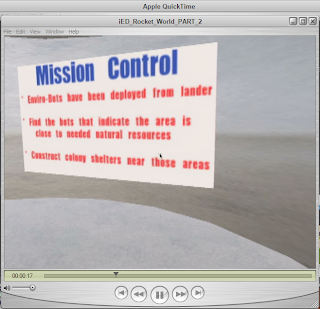1. Rocket World Module Part 1 gives high level insight on what Rocket World is, and who it pertains to. The video mentions Rocket World utilized as an iEd learning environment, globally by many people including students, educators, researchers, and NASA scientists. In providing a clip of a rocket taking off, it grasps your attention of a real rocket launching into space. It's actually an incredible clip, not only because of the intensive video, but also with the real voices of those involved with the count down and takeoff. The takeoff, and images of the rocket splitting with various videos of the spaceship in space, one can see clear and intense pictures that are truly detailed and amazing. With the parachute opening and the module landing in the water, the clip provides a detailed account of what happened with both virtual and real imagery. In general, the first rocket clip really makes one ponder which parts are totally real and which parts are virtually enhanced or created, leading us to a simulated and virtual environmental perspective. Moreover, the simulated environment, the rocket ride to outer space, with opportunity for questions and answers with an actual NASA engineer provides a great virtual and real educational learning venue, utilizing the iED virtual environment and platform for global classroom learning collaboration and interaction.
2.The Rocket World Part 2 clip reveals a Mars simulator introducing enviro-bots that point students to natural resource locations where they target creation of colony shelters. Students can have fun looking for the bots, utilizing them to provide the actual shelter locations for learning. This is an interactive way for students to learn what Mars may look like, what scientists can do, while participating in a task/game as though they are working with a NASA rocket scientist. Again, this provides learning opportunity in a simulated and fun environment that integrates real and virtual venues for education.
3.Rocket World Part 3 provides us video on a NASA Spacewalk Simulator that works on repairing the Hubble Space telescope. Seems that this is like a game where it lists some hidden items that you need to find. While it is in a simulator, you also see provided information about moving an avatar with the WASD keys, where, for instance, "w" is hinted as a way to move forward. At the end of the clip, you see a congratulations - you found everything message. Seems like a fun way to learn about repairing the Hubble Space telescope in a virtual environment!
4.The fourth video clip, Rocket World Part 4 shows virtual rocket experiments. We see virtual rockets created with simulator technology on a laptop. You can build rockets, varying on sizes in relation to our human sizes, in virtual environments that can be utilized in a myriad of virtual possibilities. This provides another varied and educational learning opportunity in a simulated environment.
5. Providing us details on students experimenting with real rockets, Rocket World Part 5 gives us a nice viewpoint on children building real model rockets at various young ages. A fun way to work with real rocket models, the children will learn about rocket structures and propelling into air as well as building parachutes necessary for smooth landings. This video provides a nice perspective on real rocket building from beginning to end that students can utilize as a learning platform towards simulation environments containing virtual rocket building opportunities.
6.Our last video clip, Rocket World Part 6, gives us additional insight on the integration of real and virtual rockets and objects. One can see mixed reality between real and virtual objects where the line between the two types of objects seem to be a blur. Where both virtual and real objects are integrated in a video together, both the real and virtual objects look real as the child is holding them both in his hands, although some objects change shape with height variances as the student moves them to different heights relative to the camera. Additionally, it is also very interesting to see some of the technology creating some of the virtual objects in the clip above the objects, providing additional insight on the video virtual object creation. Again, Part 6 reveals a mix of virtual and real objects, providing us additional simulated learning venues.






No comments:
Post a Comment